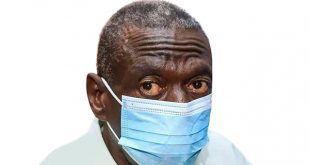
By Haggai Matsiko
Warders increasingly suffer violence as prisoner human rights observance increases in towns
On June 14, Denis Bakisu , an inmate at Mbale Prison, was taken to Mbale Regional Referral Hospital for a tooth extraction. Unknown to prisons officials, Basiku was faking his pain as part of an escape plot. When he arrived at the hospital, escorted by Mbale Prison warder Okumu Ponsiano, Bakisu was unhandcuffed but instead of moving into the dental chair, he whisked a bowl of boiling water and poured it onto Okumu. As Okumu wallowed in pain, Bakisu escaped through the front door.
Today, Bakisu is still on the run while Okumu has severe burn wounds and is still recovering at Mbale Regional Referral Hospital.
The incident, however, exposes a larger, dangerous trend emerging in prisoner-warder relations.
In the past, abuse perpetrated by warders against prisoners has been common in jails around the country. According to the Uganda Human Rights Commission (UHCR) there were 21 cases reported in 1997, but the number had grown to 314 by 2008. This led the UHCR and Uganda Prisoners Aid Foundation (UPAF) to lobby intensely for proper respect of prisoners’ rights.

The issue was viewed with such importance that the Uganda Prison Service (UPS) from 2004-2006 obtained funding from the European Development Fund (EDF) of the European Union (EU) to survey and assess the human rights situation in prisons.
The survey identified that prisons had low human rights awareness, shortage of health facilities, long stay of prisoners on remand (over 3 years) and was rampant with physical torture. Sensitisation programmes and human rights training were consequently integrated into the manual used by prison officials as part of their training curriculum.
Prisons officials say that over 1000 warders have enrolled in human rights training countrywide and that over 20 officials are in prison for violating prisoners’ rights. Observers, say there is a lot of vigilance by human rights activities and the Uganda Prisons Service now operates an open door policy that has enabled more accessibility by investigators, including members of the public and human rights activists, to prison premises.
UHRC’s directorate of investigations carries out investigations in all prisons countrywide every year and has interview sessions with prisoners to listen to their experiences and inform them of their rights.
Frank Baine Mayanja, the Public Relations Officer for UPS, says that as much as the human rights activists focus on the rights of prisoners, the extra caution is putting warders in compromising situations.
“There is a problem of over-stretching the concept of human rights especially for only the inmates because it threatens the warders and the prisoners turn against them,” says Mayanja. “We have a lot of well-trained and extremely dangerous ex-servicemen who exploit the laxity of threatened warders and torture them.”
Cases of prisoner-torturing-warder are consequently on the rise. In fact, in a letter dated September 3, UPS notified the UHRC and UPAF that there was need for them to pay attention to the growing trend of torture that prisoners are inflicting on warders.
“This is to bring to your attention the emerging trend of inmate to staff violence,” the letter reads. “So far, cases of that nature have been registered in Mbale, Masaka and Isimba prisons.”
In Basiku’s case, he allegedly took advantage of his right to health, as provided for under the Prisons Act 2006, which allowed him to torture Okumu and escape. Mayanja however, blames such incidents of prisoner-warder-torture on the prisons poor infrastructure. Under normal circumstances, Basiku should have been treated at Mbale Prison but the prison did not have the sufficient medical facilities, in violation of the United Nations Standard Minimum Rules for Treatment of Prisoners. The standards require a prison to have functional medical facilities with trained doctors and attendants.
However, a 2008 Uganda Human Rights Commission report shows that only 22 percent (48) of the 222 prisons in the country have functioning health units.
Mayanja explains that another problem is that the prisons service is understaffed. The warder-prisoner ratio is still 1:4 contrary to the international standard of 1:3. This, Mayanja adds, makes it hard to monitor prisoners, especially rowdy ones, and provides prisoners with opportunities to overpower warders. However, despite these claims by prison officials, the attention of Human rights activists continues to focus on the side of prisoners.
Samuel Okiria, the Secretary General of UPAF says that it is still rare to think of prisoners attacking warders. “The relationship between the two is always suspicious,” he says. “They tend to pretend, so it is always hard to tell.” Okiria says that cases of prisoner torturing warders could be as result of harassment or laxity by the warders.
However, Okiria says that complaints to UPAF are still dominated by reports that prisoners are tortured in rural areas. He says that former prisoners are also threatened by prison officials from attempting to report cases of torture in prisons. Okiria says that a former prisoner who was reporting for UPAF from Mbarara was on several occasions warned and was later framed for armed robbery and murdered.
“We were shocked to see him in papers dead but you could tell that the gun was just put across his body,” he says. “He used to say he was always threatened. We receive several cases from rural areas where prisoners are forced to pause with exhibits that are often got from prison stores.”
The most recent torture case was at Kirinya prison in Jinja where a warder severely brutalised Godfrey Dhikusooka on Feb. 16. Dhikuusoka, who had been arrested on Feb. 10 on charges of child neglect, suffered scars to his face and arms, lost his sight and was left unable to walk. Despite his claims of abuse by a warder called Godfrey, prison officials said Dhikuusoka had been beaten by inmates.
Earlier, an inmate in Loro Prison in Gulu, John Okwang, was tortured into paralysis; in February, 24-year-old Justine Orach, was reported to have died after he was tortured by a prisons’ officer. He is said to have been beaten and hanged on a tree as punishment for fighting another inmate.
The UHRC had previously named Pece, Murchison Bay and Sentema as prisons where torture of prisoners has been the most common.
In fact at Sentema Prison in Mpigi district, a warder became so angry with a prisoner while guarding inmates as they were out digging, the he grabbed his hoe and started cutting the inmate into pieces. The prisoner miraculously survived and was compensated Shs 30 million after filing a complaint with UHRC.
Compensating torture victims is reported to have cost the government lots of money. Between 2003 and 2007, UHRC awarded victims of torture over Shs 2 billion in compensation for human rights abuses they had suffered in custody. The 2007 UHCR report shows that in 2006 torture cost the government Shs 261 million, representing 71 per cent of the annual awards for human rights violations. Of the Shs 593 million awarded by the UHRC tribunal, Shs439 million went to victims of torture. A big number of these abuses were committed by prison authorities.
In Kampala, however, the situation is very different. A former political prisoner who declined to be identified told The Independent “prison life has changed and that warders now handle prisoners with a lot of caution unlike before when torture was the order of the day.”
Mayanja attributes this improvement to the implementation of the Prisons Act 2006 and other international compendiums, which aim at bringing the Act in line with effective and humane modern penal policy and universally accepted internal standards.
Mayanja says that the prisons policy now concentrates a lot on upholding human rights. He says that abuse of human rights is highly punishable and that over 20 prison staff are in prison for abusing human rights. He adds that UPS was training over 1000 staff in refresher human rights courses to ensure that they are conversant with the subject of human rights.
 The Independent Uganda: You get the Truth we Pay the Price
The Independent Uganda: You get the Truth we Pay the Price



For ease of my reference , a copy is attached here to marked Annexture